|
The Thompson is a big river and can appear ominous to those newcomers
journeying to fish it. The river's flow can vary from a high of around
100,000 cubic feet per second (300 cubic metres per second) with a
river-gauge reading of 7 metres (23 feet) at the peak of the freshet
in spring, to flow of less than 5,000 subic feet per second (150 cubic
metres per second) with a river-gauge of less than 1 metre (3 feet),
during the low flows of late autumn and winter. The maximum
flow from the spring runoff usually occurs in June and then the river's
flow drops, often continually, until February or March. It is the lower
flows of late September through the regulated end of the fishing season
on December 31 that are of interest to steelhead fly fishermen.
About 160 miles (257 kilometres) up the Fraser from Vancouver, the
Thompson joins the Fraser at Lytton. Twenty-three miles (37 kilometres)
up the Thompson from Lytton is the old Cariboo Wagon Road town of
Spencers Bridge. This area, in and around the town and upstream and
downstream, has the better fly fishing runs. For visiting fishermen,
Spencers Bridge, with its motels and auto courts, has ample accommodations.
However, it can get crowded during the peak of the season - from the
last two weeks of October through November - and visiting anglers planning
a trip should make reservations. For the recreation vehicle driver or camper,
there are numerous roadside camping areas.
The steelhead migrate through the Fraser in late August, September, October
and early November. The run's forerunners - those that manage to escape
the commercial nets, bar fishery, native food fishery and poaching - show up
around Spencers Bridge in late September or early October, depending on
water conditions. I live in Vancouver, not far from the mouth of the Fraser
River. It is an 185-mile (300-kilometre) drive to Spencer's Bridge. My route
follows the river's course to the sea but in reverse. I travel up the Fraser
Valley to Hope; then up the Fraser Canyon, past Boston Bar and Hell's Gate
to Lytton; and from Lytton up the Thompson past Shaw Springs to Spencers
Bridge. My journey is comparable in distance to that swum by the steelhead.
But, mine takes a matter of hours; the fish's, many days. For a MAP
of the Thompson River, click
here.
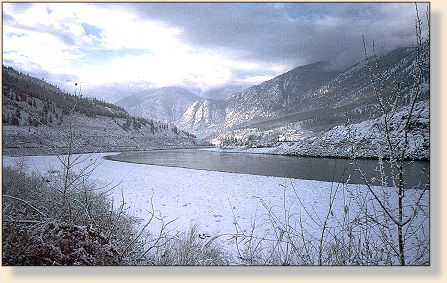
The Thompson River offers a skilled fly fisherman many challenges: big water,
difficult-to-find fish, some horrendous wading, and, at times, trying fishing
conditions. But the rewards can be worth it because the Thompson River is
home to world-class, catch-and-release steelhead that respond well to a properly
presented fly through the October to December-end fishing season.
For hundreds of years humans have shown a fascination for fish and, in
particular, game fish in rivers. One such fish, the steelhead, is a mysterious
fish that appears from the sea strong, sleek and silver to ascend our rivers
at varying times of the year on its spawning run. It is also a fish of great
beauty and like many other objects of beauty that attract human beings,
even if very briefly, it is something to be possessed. Furthermore, to the
fly fisherman, the steelhead is a challenging fish to catch. Because of
these attributes - mystery, strength, beauty, being a challenge to catch -
the steelhead is a highly regarded game fish. some who have a lasting
love affair with the steelhead believe it is equal to what many consider
the king of game fish - the Atlantic salmon.
The bulk of the Thompson stock consists of five-year-olds,
averaging 15 pounds (7 kilograms) but fish of over 30 pounds (14 kilograms)
have been taken. Some fish stories report that 40-pounders (18 kilograms)
have been lost. The Thompson fish is unique not just because of its
size but because many of the fish tend to be "screamers" or "heart-stoppers."
They take the fly violently and before you know it, there is a 15-pound
(7-kilogram) steelhead cartwheeling around the river with 100 yards
(91 metres) of line out. What a thrill!
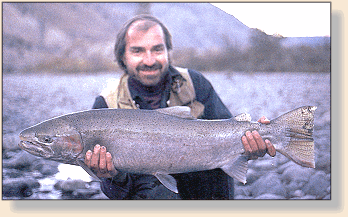
Methods of Presentation
There are five methods of presenting flies to steelhead: floating-line, skated -
or waked-fly, sunk-line, dry fly and upstream sunk-fly presentation. A
successful fisherman knows them all and is adept at recognizing conditions
that require the fly to be presented a certain way. Only three methods -
floating-line, sunk-line and skated or waked-fly - are widely used Thompson
River presentations. The other two methods require precise work and although
they do work elsewhere, the conditions that are a necessity - knowing fish
are in a certain spot, in water that can be fished from below and fish that are
within a suitable presentation range, say 30 or so feet (9 or so metres) - are
not too often encountered on the Thompson River. Fly fishers are best off
concentrating on presentation methods that suit the coverage of large
bobies of water. The two most productive are the floating-line and
sunk-line methods.
Floating-Line:
Through October to about November 15 in all depths to about 6 feet
(2 metres) maximum. The water temperature is usually in the mid to high
50s (13 to 15 C) at the beginning of October, in the low 50s (10 to 12 C) at
the end and about 45 F (7 c) in mid-November. From mid-November in
water that is wadeable to a maximum of 4 feet (1.2 metres) and that is
not to streamy. Fish are slow to react in cooler waters and are reluctant
to move far for the fly.
Sunk-Line:
At any time if the water is greater than 6 feet (2 metres) deep and/or in
locations that you know are good holding spots. In cooler water
temperatures, usually found from mid-November onwards and in water
that is greater than 3 feet (1 metre) deep.
Fly Patterns
I have sampled about three dozen British Columbian steelhead streams
and the Thompson, a river that presents many difficulties to steelhead
fly fishermen, is no different from most other rivers; it is just a hell of
a lot bigger. To achive consistent results, steelhead fly fishers should
take the following factors into consideration when choosing their fur
and feather enticements:
- Light conditions - whether it is sunny, cloudy or the water is shaded.
- Water conditions - temperature, clearness, velocity and surface turbulence.
- Time of day - early morning, mid-day, evening.
- State of the fish - fresh-run or present in the river for some time.
When fishing conditions deteriorate - and they do daily - the skillful, knowledgeable
fly fisher shines over those average-skilled ones. By marrying fly fishing method to
conditions and fly selection, [For the FLIES for the Thompson River, click
here.]
a competent fly fisherman can often catch fish even under the most trying
conditions. The most trying conditions that I can think of are mid-afternoon on
a glassy run, baked in sunshine - typical Thompson river mid-day fishing
conditions.
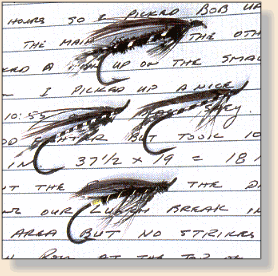 To avoid wasting time trying different types of flies, concentrate more on
matching technique with conditions and keep fly choices to a minimum.
There are diver patterns from which to choose: just look at any steelhead
fly fishing book; the selection is almost limitless. Some successful B.C.
patterns are the Doc Spratley, both As Specifieds, the Black Spey, the
Black General Practitioner and the Eastern Canadian Atlantic Salmon
Bomber.
To avoid wasting time trying different types of flies, concentrate more on
matching technique with conditions and keep fly choices to a minimum.
There are diver patterns from which to choose: just look at any steelhead
fly fishing book; the selection is almost limitless. Some successful B.C.
patterns are the Doc Spratley, both As Specifieds, the Black Spey, the
Black General Practitioner and the Eastern Canadian Atlantic Salmon
Bomber.
Other fishermen will have their favorite and as long as the fly you choose
complements the conditions and presentation method, it will suffice.
Patterns originating south of the 49th parallel that do just as well include
the Skunk, Purple Peril, Black Woolly Bugger and Grease Liner. Having
confidence in a pattern increases your chances of success but to achieve
consistent results you may have to abandon favorites in order to match fly
patterns to conditions and presentation. Many anglers think that because
the Thompson is a big river with big fish a big fly is necessary. This is
false. I have caught steelhead on flies up to 5/0 and these big flies are
useful to match certain conditions. Because of the desert setting and
the light conditons that go with almost constant sunshine, however, to
marry those conditions to the warmer water temperatures and the
flat-surfaced pools of the Thompson, I rely much on my sparsely
dressed flies on size 2 and 4 hooks.
A Head's Up
If you are coming to British Columbia to fish, you should know that
British Columbia has a river classification system and guide policy.
The Thompson river is in the Class II category and to fish during
steelhead season requires a special permit for out-of-province fishers.
Professional guiding is not permitted on the Thompson from Savona
to Lytton and there are no fly fishing shops. If you visit the Thompson
you are on your own and should come prepared to search out the
waters. You should also bring ample fishing equipment - rod, fly
lines, waders, wading staff and cleats (for treacherous, difficult
wading) and a camera to catch that once-in-a-lifetime fish on film.
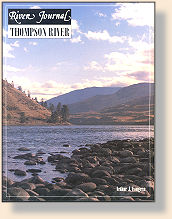
For information on Thompson River fishing regulations, licensing
and fishing write:
Fisheries Branch
Ministry of Environment, Lands and Parks
Southern Interior Region
1259 Dalhousie Drive
Kamloops, British Columbia
V2C 5Z5 Canada
A closing thought for those planning to challenge the Thompson river:
the Thompson . . . is a tough river and each fly-caught fish is an
achievement. Some years ago an old gear-slinging acquaintance of
mine questioned me about fly fishing for steelhead. He just couldn't
see the magic I found in it. At the time, I was stumped for an answer.
On reflection, however, I should have told him, "The steelhead we
should prize the most are those that we have worked the hardest for."
That is what each Thompson fly-caught fish is: A prize won from
much hard work. ~ Arthur J. Lingren
For a MAP of the Thompson River, click
here.
For the FLIES for Thompson, click
here.
To ORDER Thompson River direct from the publisher, click
HERE.
Credits: From Thompson River part of the River
Journal series, published by Frank Amato Publications.
We greatly appreciate use permission.
|




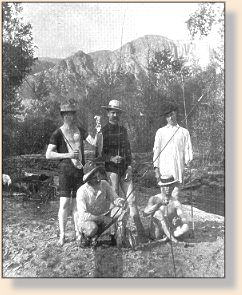
 To avoid wasting time trying different types of flies, concentrate more on
matching technique with conditions and keep fly choices to a minimum.
There are diver patterns from which to choose: just look at any steelhead
fly fishing book; the selection is almost limitless. Some successful B.C.
patterns are the Doc Spratley, both As Specifieds, the Black Spey, the
Black General Practitioner and the Eastern Canadian Atlantic Salmon
Bomber.
To avoid wasting time trying different types of flies, concentrate more on
matching technique with conditions and keep fly choices to a minimum.
There are diver patterns from which to choose: just look at any steelhead
fly fishing book; the selection is almost limitless. Some successful B.C.
patterns are the Doc Spratley, both As Specifieds, the Black Spey, the
Black General Practitioner and the Eastern Canadian Atlantic Salmon
Bomber.